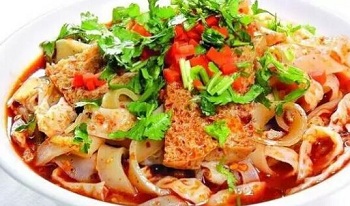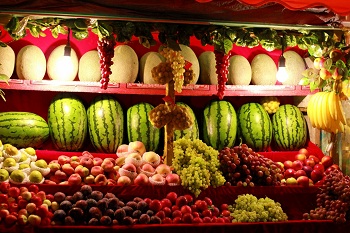As one of the important travel destinations in China, where you can taste the variety of Xinjiang delicacies. The food and drink in Xinjiang are very much like the people themselves - unique and with a very exotic character. While the taste of the food on offer in the region may not suit everyone's tastes, but it is always a good idea to try it while you are there, as it would give you a different experience of flavor. It is also a great way to learn more about Xinjiang culture, as there is no better way to get to know someone than by breaking a loaf of bread with them.
What to Eat During Your Xinjiang Tour?
Most Recommended Uyghur Food You Should Try
Mutton Kebab
Xinjiang's mutton is famous for its delicacy and Kebab is one of the most popular and traditional mutton cuisines among residents. The chef would season mutton with salt, chili powder and cumin powder which are helpful to reduce the odor and enhance the flavour of the meat. In most cases, local mutton kebabs are roasted on a special grill using anthracite as the fuel. Therefore, in a night market, we can notice the smell of kebabs from a long distance. It's a delicacy that should not be missed by anyone who comes to Xinjiang.
Roast Whole Lamb
A roast whole lamb is a famous dish of Xinjiang cuisine. Usually, it would be served on important events like traditional festivals and weddings, but sometimes local people would treat their distinguished guests with this high-class cuisine, too. In order to cook a perfect roast whole lamb, the lamb we use must be less than two years old and the meat will be seasoned for several times with a secret sauce which contains a variety of ingredients before being placed in a specially-made oven. In addition to its quality raw materials and unique cooking method, the way to enjoy the dish is quite interesting, too. The food usually will be served like the pic showed above, guests are free to choose and cut any parts they want to have.
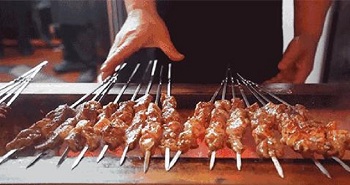
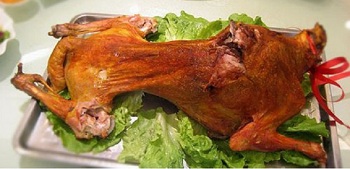
Naan
Naan, a kind of round baked cake, has a long history in Xinjiang and it was called "Hu bin" or "Lu bin" in ancient times. The main raw material of naan is flour, mostly fermented flour, and instead of edible alkali, salt is used in the cooking method. In addition to the flour mentioned above, sesame, onion, egg, oil, shortening, milk, and sugar are also indispensable raw materials. Naan tastes delicious and crispy, which is the daily food of Uygur people in Xinjiang.
Xinjiang Big Plate Chicken
Xinjiang big plate chicken is also called "Shawan big plate chicken". Though it only has a relatively short history compared with other local traditional cuisines, it's definitely one of the most popular foods in Xinjiang and you can't afford to miss that. On 10th September 2018, when "Chinese Cuisine" was officially released, "big plate chicken" was named one of the top 10 classic dishes in Xinjiang.
As there are a thousand Hamlets in a thousand people's eyes, there are also a thousand "Da Pan Ji" on a thousand people's tongues.
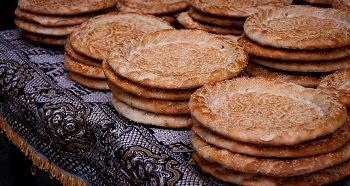
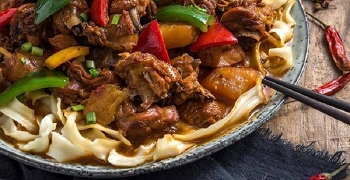
Xinijiang Noodles
Xinjiang noodles, commonly known as "Latiaozi" or "Banmian", and the name of it comes from the way we eat it and how we make it. From the point of view of scientific diet, Xinjiang noodle is a portion of food combining vegetables(vitamin and cellulose) and noodles(carbohydrate). Both meat and vegetable dishes are available, and the flavor can be adjusted according to the taste and order of the guests. It may sound kind of like spaghetti, but the flavor of it is totally different.
Lamb Pilaf
Lamb pilaf is one of the favorite foods of all ethnic residents in Xinjiang. Zhuafan is the Chinese name of the lamb pilaf. It is called "polo" in Uygur, originally in Persian. It means rice braised with mutton(or beef), rice, yellow radish and oil. According to historical research, lamb pilaf was first created in the Northern Song or Earlier Song Dynasty (960-1127 AD). It is a combination of nomadic culture and farming culture. And there is a story about it.
Legend has it, there was a doctor named Asheliebisi. He was weak and ill in his old age, no matter what kind of medicine he took, it didn't help. Occasionally, he invented a recipe of braised rice which contains carrot, onion and mutton. After a period of time of eating it, his body recovered quickly. So he introduced it to his friends and relatives, then, lamb pilaf started to gain its popularity.
Baked Samosa
The Baked Samosa is one of the famous Uygur snacks and it's called “Kaobaozi” in Chinese. This is a delicacy that can only be found in Xinjiang, so do not miss it. More importantly, from the view of scientific diet, the nutrient of onion and mutton used in the filling of baked samosa can be complementary which could be helpful to people's physical health. In particular, eating onion has the function of dissolving thrombus and dilating blood vessels, so Uygur people who often eat baked samosa are less likely to suffer from thrombosis.
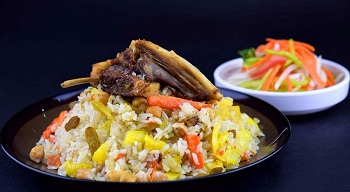
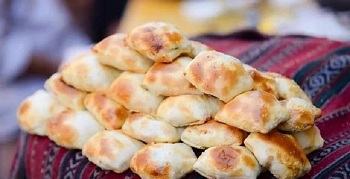
Liangpizi
Another popular Xinjiang snack is “liangpizi”. It is different from the “liangfen” and “mianpizi” from central China. “liangpizi” is made out of steamed flour water. It is chewier than “liangfen” and looks more transparent than “mianpizi”. It's served with a kind of special sauce and tastes simply unforgettable.
Fruits
Fruits are not food in a narrow definition, but Xinjiang enjoys a high reputation for its fruits no less than the cuisine. Plentiful sunshine and significant difference between daytime and nighttime temperatures make fruits in Xinjiang extraordinarily sweet and juicy.
Shanshan watermelon, Turpan grapes, Hami melon, Korla pears, Yecheng pomegranate, if you visit Xinjiang in summer, you will embrace a sweet wave of fruit feast as the region enters into the season of harvest.
The recommendations above do not cover all the dishes in the food paradise. The world of food in Xinjiang is waiting for you to explore.
